Poppy
Hazard to Others
  
Posts: 294
Registered: 3-11-2011
Member Is Offline
Mood: † chemical zombie
|
|
How often does atomic radius match?
Hello guys I've been working with crystals and one thing which could be found here is that it have been noticed that double salts tend to grow
smoother and larger crystals comparetively to their atomic countparts.
As an example, (NH4)2Fe(SO4)2 forms nice looking and will defined seed crystals im comprasion with FeSO4 alone or much worst (NH4)2SO4, hitherto the
Fe2+ lasts longers resistent to oxidation when trapped as double salts.
Serendiptously my experimentation and lack of immedtiate disposal of mixtures highlighted a possibily ultraeasy crystal growing formulation,.
consisting of rounded equal mols of sodium dichromate and ammonium sulfate.
Account is that various transparent, orange tinged, flawless monoclinic seed crystals up to 2 cm long had formed to by leaving the solution to
evaporate at atmospheric conditions.
Right now the product has gained a new batch from which hopefully thr same crystals will appear again, now with 3 times as massive.
If I could, as once have done, make a way to find somewhere around, the trend with which each ionized atom may perform association with other ion
according to their solubilities or ratio of their volume, etc, thus posing a pattern for the double salts possible
combinations.. but I couldn't find a hint anymore.
Pictures will be posted along with the results. Ammonium ferrous sulfate seed selection was already performed with a few exceptional pieces, which
will be grown inside a specially constructed apparatus intended for temperature control up to a scale of 1°C/Day.
|
|
|
Poppy
Hazard to Others
  
Posts: 294
Registered: 3-11-2011
Member Is Offline
Mood: † chemical zombie
|
|
I little thoery before results,
It seems most salts are, to some extent, crystalized in the homogenous solution itself. The formation of ionic pairs of the kind XmYn (s) --> XmYn
(aq) seems to be the key for a stable crystal growth, where the crystals have a degree of freedom which is not too much so that in turn as to
accidentaly inflict malformations on the main crystal.
This seems to be the case with double-salts, and also salts made off acids and bases of commonly low ionization constants in water ( Al(OH)3 in the
case of alum, (H3PO4) in the case of ADP, NH3 and Fe(OH)2 in the case of ammonium ferrous sulphate).
They say that double salts in solution act normally as separated ions of their primordial salts - that to a certain degree. There must be some
correlation between the solvated phase and the process of precipitation.
The picture, from Harris, cap. 8
Too bad I'am out of a camera, but some information concercing the first investigated salt will be supplied:
By dissolving an equimolar mixture of FeSO4.7 H2O and (NH4)2SO4 it was obtained a mass of 696g of ammonium ferrous sulphate. To a concentrated
solution of ammonia comprising 308g of that, 650g of ferrous sulphate were added slowly until completely dissolved. The mixture reached
a dark green colour as a probable suspiscious oxidation of Fe2+ during the process, the fenomenon later proved to be somewhat wrongly interpreted.
After cooling the cian green colour was recoverd, indicating the decoloration was some other sort of reason. The solution was recrystalized 4 times,
with the final lasting 100mL comprising a brown liquor, with a little 5g of salt in it that was thrown away and not accounted for the yield.
After each crystalization, data was collected regarding the purity of the produtcs:
1st crystalization: pH of the solution: not measured
pH of the dissovled crystals: not measured
2nd crystalization: pH of the solution: 1.5
pH of the dissolved crystals: 3.3-3.4
3rd crystalization pH of the solution: 1.1
pH of the dissolved crystals: 3.2
4th crystalization: pH of the solution: not emasured
pH of the dissolved crystals: 1,6
(this with a brown tinge)
residue: pH 0,5, density 1,4
Everytime the solution was heated the color darkened, turing dark green at the first crystalizations to dark yellow and finally brown with the
residue.
I'm sorry I forgot to pick the first crystalization data, lol.
The yield, 696g, far from the theorical 914g of hexahydrate, believedly is a trustworthy data.
The solubility at 16,5°C, aprox. 52g/ 100g water.
Density: 1,16g
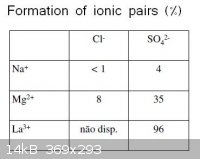
Oh almost forgot. The tendency of the solution to go brown is probably due to the formation of some complex. After cooling all the solutions almost
completely recored its cian color.
It have been succeded to "revive" old stored FeSO4 acidic solution which turned brown by dripping more sulphuric
acid to it. I mean dripping because a few mL are required per liter for ressussection to take place. Recrystalization gows very diffrently without
reviving: non purificable mass of brown crystals are resulted when the solution is left unhealed, otherwise nice purified crystals rises from it, when
after pouring moer acid, the liquid magically turned cyan-green again! (not as cyan as expected for fresh baths unfortunatly)
Its Le-Chatelier principle baby! (or some sort of Fe3+ acting as an oxidizing agent ?)
[Edited on 6-25-2012 by Poppy]
|
|
|
blogfast25
International Hazard
    
Posts: 10562
Registered: 3-2-2008
Location: Neverland
Member Is Offline
Mood: No Mood
|
|
Quote: Originally posted by Poppy  |
By dissolving an equimolar mixture of FeSO4.7 H2O and (NH4)2SO4 it was obtained a mass of 696g of ammonium ferrous sulphate. To a concentrated
solution of ammonia comprising 308g of that, 650g of ferrous sulphate were added slowly until completely dissolved.
[Edited on 6-25-2012 by Poppy] |
Huh? Did you mean 'ammonium sulphate' instead of 'ammonia'??
|
|
|
Poppy
Hazard to Others
  
Posts: 294
Registered: 3-11-2011
Member Is Offline
Mood: † chemical zombie
|
|
Isn't that correct? I think I must pursuit to review all the formulas..
|
|
|
blogfast25
International Hazard
    
Posts: 10562
Registered: 3-2-2008
Location: Neverland
Member Is Offline
Mood: No Mood
|
|
"To a concentrated solution of ammonia comprising 308g of that, 650g of ferrous sulphate were added slowly until completely dissolved."
650 g of ferrous sulphate (heptahydrate) and 308 g of ammonium sulphate is a molar ratio of 1:1 and what you need to make Mohr's
Salt.
Adding ferrous sulphate to ammonia solution (NH3 (aq), sometimes referred to as 'NH4OH') causes ferrous hydroxide to precipitate,
which in air will quickly oxidise to Fe2O3.nH2O.
[Edited on 26-6-2012 by blogfast25]
|
|
|
Poppy
Hazard to Others
  
Posts: 294
Registered: 3-11-2011
Member Is Offline
Mood: † chemical zombie
|
|
The calculations were right! Ammonia was mistaken as ammonium sulfate.
Another batch is in the owen, this time involving 1270g of FeSO4.7 H2O the results well be carried with measurements to add confidence to the previous
one.
AS said, and somewhat related to the preparation overhall, here are shown some pics:
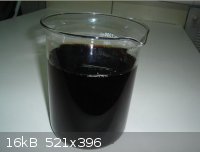 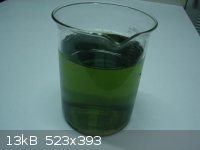 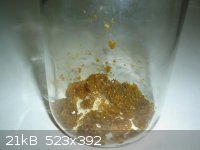 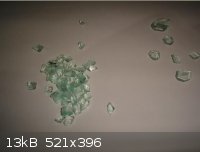
From right to left: seed crystal grabbed from the cooled reaction vessel (left) and from an evaporated sample - all beatiful, too bad I took them with
my hands so I'm afraid the growth will be halted due to fat sticking to the crystals faces, anyway, this can supposedly be saned with white gasoline
or something.. - the brown crystal are the result of recrystalization on a sample of the so called "dead" liquor. The yiled was lower too. - The
revived, green solution: not cian as the very first freshly made but this gives normal FeSO4.H2O big time. - Dead solution, as seen before adding
conc. sulfuric acid to it. Most probably there's not very much Fe3+ at all?
Or did the dissolved oxygen created hydroxi ions in solution, which are reduced by the acid in a way similar to the equation:
4Fe2+ + O2 + 2 H2O --> Fe3+ + 4 OH-
H2SO4 --> H+ + HSO4-
2Fe3+ + HSO4- + OH- -->Fe2+ + H2O + H2SO4
Who knows..
Aproximately 0,15 mol of acid were needed to do this, per liter of liquor.
As to the other possible double salts, I could find some formulas, mostly alums,
Na2Cr2O7.(NH4)2SO4
Fe2(SO4)3.(NH4)2SO4
FeSO4.(NH4)2SO4
KAl(SO4)2·12H2O.
(NH4)Al(SO4)2·12H2O
NaAl(SO4)2·12H2O or Na2SO4·Al2(SO4)3·24H2O
FeAl2(SO4)4·22H2O
MgAl2(SO4)4·22H2O
NaAl(SO4)2·6H2O
KCr(SO4)2·12H2O
Make it clear the purpose is to provide a global visualization on the easiness of crystal growth useing simple double salts IMHO. I don't know if
coumpounds like " [Ag(CH3NH2)2][Mn(H2O)2(c2O4)2] " are even double salts at all but as they are difficult for amateurs to prepare they're not
assembled here.
[Edited on 6-27-2012 by Poppy]
|
|
|
blogfast25
International Hazard
    
Posts: 10562
Registered: 3-2-2008
Location: Neverland
Member Is Offline
Mood: No Mood
|
|
Quote: Originally posted by Poppy  |
Another batch is in the owen, this time involving 1270g of FeSO4.7 H2O the results well be carried with measurements to add confidence to the previous
one.
|
If you get your calcs right there is no need for an ‘oven’. Add solid ammonium sulphate to a hot, saturated, slightly acidified solution of
FeSO4.7H2O. Stir to dissolve all the ammonium sulphate while keeping hot. Then allow to cool to RT and fridge after that. Crystals of Mohr’s Salt
form, yield 70 % +. Seed crystals are usually not needed for Mohr’s Salt. Dry the crystals at RT (higher temperatures WILL cause partial oxidation)
on something absorbent.
Any Fe3+ formed in such a solution can be reduced by adding some steel wool: Fe (0) + FE (III) == > 2 Fe (II). Just adding acid doesn’t do it.
|
|
|
Poppy
Hazard to Others
  
Posts: 294
Registered: 3-11-2011
Member Is Offline
Mood: † chemical zombie
|
|
You mean I could just spare all that time by freezing the solution as fast as possible?
Aww man.. but I wont get rid of those crystals, they're so nice!
I've got some other formulas for doublesalts aswell, gonna post them soon enough.
Thank you
Oh, still, a little hint is on the press
As the solution is always acidic, sulfuric acid is needed to prevent Fe2+ ions to merge into Fe2O3.yH2O, which is a thousand times preferred over
Fe(OH)2 and will cause some iron to precipitate irreversibly while at the Fe III state. The ammount of ferric oxide precipitate could be estimate by
crude eye to range over 5- 10g right after raising the temperature to 100°C, so the required ammount to reach equimolarity at this equilibrium range
is thought as being something like 10g, at best. The first extraction was carried with excess acid, while this one pictured had no excess acid at all.
You can see its milky appearance.
Although FeIII appeared while heating the first batch and all subesequent crystalizations during the period of heating, it reversed back to FeII to a
great extent, assuming color transitions. As of the stoichometric solution by itself alone, it couldn't hold the 3+ ions which precipitated.
Once precipitated, there's no thing you can do, rip.
[Edited on 6-28-2012 by Poppy]
[Edited on 6-28-2012 by Poppy]
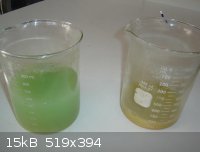
|
|
|
Poppy
Hazard to Others
  
Posts: 294
Registered: 3-11-2011
Member Is Offline
Mood: † chemical zombie
|
|
Ammonium Iron II sulfate is anhydrous, as confirmed by this following batch:
1270g FeSO4.H2O were added to 603g ammonium sulfate
(thx blogfast for the correction)
Both ingredients were in big crystal shape so water content was minimized to hydration only.
The yield was 1553g from recoverable crystals, plus 150mL of a liquor which I assume must contain around 90g of product.
Lately someday I will perform an experiment so as by evaporation determine about the precise yield and vanish with this hexahydrate formula found at
wiki once and for all!! 
The salts are now ready for a massive crystal growing experiment.
|
|
|
unionised
International Hazard
    
Posts: 5102
Registered: 1-11-2003
Location: UK
Member Is Offline
Mood: No Mood
|
|
"Ammonium Iron II sulfate is anhydrous, as confirmed by this following batch:"
That would be odd
"Ammonium iron(II) sulfate, or Mohr's Salt, is the inorganic compound with the formula (NH4)2Fe(SO4)2·6H2O. "
from
http://en.wikipedia.org/wiki/Ammonium_iron(II)_sulfate
It's the salt of the Fe(H2O)6 ++ ion
Also, as it has been used countless times as a standard for redox titrations, someone would have noticed if it were anhydrous.
|
|
|
Poppy
Hazard to Others
  
Posts: 294
Registered: 3-11-2011
Member Is Offline
Mood: † chemical zombie
|
|
I might be terrifyinlgy wrong but would never admit that!

Wiki luckly also states it gives [Fe(H2O)6]2+ ions in solution
So may the ionic strenght be with you.
|
|
|
blogfast25
International Hazard
    
Posts: 10562
Registered: 3-2-2008
Location: Neverland
Member Is Offline
Mood: No Mood
|
|
Quote: Originally posted by Poppy  | I might be terrifyinlgy wrong but would never admit that!

Wiki luckly also states it gives [Fe(H2O)6]2+ ions in solution
So may the ionic strenght be with you. |
Mohr's Salt is always a hydrate, by 'definition'...
|
|
|
Poppy
Hazard to Others
  
Posts: 294
Registered: 3-11-2011
Member Is Offline
Mood: † chemical zombie
|
|
Perhaps Mohr's salt is much harder to synthesize than we think.
How'd he put all that water into the crystals?
|
|
|
blogfast25
International Hazard
    
Posts: 10562
Registered: 3-2-2008
Location: Neverland
Member Is Offline
Mood: No Mood
|
|
Quote: Originally posted by Poppy  | Perhaps Mohr's salt is much harder to synthesize than we think.
How'd he put all that water into the crystals? |
Poppy, are you 'taking the mickey'? Nothing is easier than making Mohr's Salt. Crystal water is crystal water. PERIOD.
|
|
|
Poppy
Hazard to Others
  
Posts: 294
Registered: 3-11-2011
Member Is Offline
Mood: † chemical zombie
|
|
Blogfast You are picking on it. Why dont you just agree with me that formula is wrong all along with the theory it behaves as "normal separate" ions
in solution.
If mickey was in my hands he would be fried and sauced
And those crystals are transparent and green colore which supportedly does not contain my period's blood!!!
Jesus
[Edited on 7-1-2012 by Poppy]
[Edited on 7-1-2012 by Poppy]
|
|
|
Poppy
Hazard to Others
  
Posts: 294
Registered: 3-11-2011
Member Is Offline
Mood: † chemical zombie
|
|
Considering the yield it was calculated that aproximately, in the crystal form, ammonium iron II sulphate contains 1 water molecule for every
anhydrous salt molecule. The picture below is ascribed as in scale if in aqueous solutions, but that gives an idea. The correction on the scales can
be verified by rationalizing the density in solution of the ions to the crystal density, which I would put whereabout half those specifically.
I dont know much about crystal lattice rearrangements but I suppose Fe2+ is atached to "ammonion +" ions and the bridging water ligand to form a
tetragonal or square planar complex, while sulfate usually would balance the charges. Strange is that NH4+ is not commonly seen as a coordination
ligand, so its protons could be otherwise protonate SO4(2-) or water. Protonated water is more than 3 times as big as H2O and and also H3O+ would
(supposedly) loose its bridging properties.
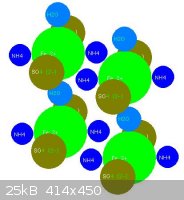
Sorry newly studied criteria states that it must be tetrahedral.
If all those double salts formula keeps like this we gonna have a bad time reconstructing the matching table.
I'm pretty sure it was somewhere here, anyone knows where???
[Edited on 7-8-2012 by Poppy]
[Edited on 7-8-2012 by Poppy]
|
|
|
Poppy
Hazard to Others
  
Posts: 294
Registered: 3-11-2011
Member Is Offline
Mood: † chemical zombie
|
|
A wide variety of double salts have been reported. I found most of them around wiki.
Many, probably, do not obay the same crude law of dissolution on dissolving or the reverse, crystal formation, although a solubility measure for
ammonium iron sulfate hydrate agreed well with the theory the salts behave as normal ions in solution, at least regarding to just solubility.
----------------------------------------
The list:
KAl(SO4)2·12H2O.
(NH4)Al(SO4)2·12H2O
NaAl(SO4)2·12H2O or Na2SO4·Al2(SO4)3·24H2O
FeAl2(SO4)4·22H2O
MgAl2(SO4)4·22H2O
NaAl(SO4)2·6H2O
KCr(SO4)2·12H2O
3Na2SO4·CaSO4,
3Na2SO4·MgSO4 (vanthoffite)
and NaF·Na2SO4.
Na2SO4·3K2SO4
tutton salts:
(NH4)2V(SO4)2(H2O)6
(NH4)2Cr(SO4)2(H2O)6.
Chlorocalcite is a rare potassium calcium chloride evaporite mineral with formula: KCaCl3
The mineral K3Na(SO4) 2 (Glaserite)
Polyhalite is an evaporite mineral, a hydrated sulfate of potassium, calcium and magnesium with formula: K2Ca2Mg(SO4)4·2(H2O)
Sodium sulfate displays a moderate tendency to form double salts. The only alums formed with common trivalent metals are NaAl(SO4)2 (unstable above 39
°C) and NaCr(SO4)2, in contrast to potassium sulfate and ammonium sulfate which form many stable alums
about amonium sulphate:
Such double metal sulfates include ammonium cobaltous sulfate, ferric ammonium sulfate, ammonium nickel sulfate and ammonium cerous sulfate
Kainite, MgSO4·KCl·H2O
Schönite, K2SO4·MgSO4·6H2O
Leonite, K2SO4·MgSO4·4H2O
Langbeinite, K2SO4·2MgSO4
Glaserite, K3Na(SO4)2
Polyhalite, K2SO4·MgSO4·2CaSO4·2H2O
from wiki, alums
Types
Many trivalent metals are capable of forming alums. The general form of an alum is AMIII(SO4)2·nH2O, where A is an alkali metal or ammonium, MIII is
a trivalent metal, and n often is 12. In general, alums are easier formed when the alkali metal atom is larger. This rule was first stated by Locke in
1902:[7] The failure of the sulphate of a given trivalent metal to unite with caesium sulphate to a compound of the type CsMIII(SO4)2·12H2O may
therefore betaken as an almost positive indication that such element has no alum-forming power whatsoever.
Double sulfates with the general formula A2SO4·B2(SO4)3·24H2O, are known where A is a monovalent cation such as sodium, potassium, rubidium,
caesium, or thallium(I), or a compound cation such as ammonium (NH+
4), methylammonium (CH3NH+
3), hydroxylammonium (HONH+
3) or hydrazinium (N2H+
5), B is a trivalent metal ion, such as aluminium, chromium, titanium, manganese, vanadium, iron(III), cobalt(III), gallium, molybdenum, indium,
ruthenium, rhodium, or iridium.[8] Analogous selenates also occur. The specific combinations of univalent cation, trivalent cation, and anion depends
on the sizes of the ions. For example, unlike the other alkali metals the smallest one, lithium, does not form alums, and there is only one known
sodium alum. In some cases, solid solutions of alums occur.
Alums crystallize in one of three different crystal structures. These classes are called a-, ß- and ?-alu
Hanksite is a sulfate mineral, distinguished as one of only a handful that contain both carbonate and sulfate ion groups. It has the chemical formula:
Na22K(SO4)9(CO3)2Cl
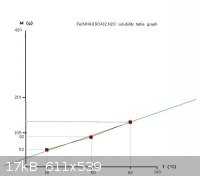
[Edited on 8-20-2012 by Poppy]
|
|
|
blogfast25
International Hazard
    
Posts: 10562
Registered: 3-2-2008
Location: Neverland
Member Is Offline
Mood: No Mood
|
|
Also interesting are rare earth magnesium nitrate doubles: RE2Mg3(NO3)12.24H2O
|
|
|
Poppy
Hazard to Others
  
Posts: 294
Registered: 3-11-2011
Member Is Offline
Mood: † chemical zombie
|
|
So this is what I am talking about. This crystal has grown up as an unusual guest an unexpected visitor. At first resemblance it appears as bearing
the well known purple Cr3+ or Nd3+ atoms in its structure, but in fact it does not contain, AFAIK, any of the commonly found elements that match for
this color.
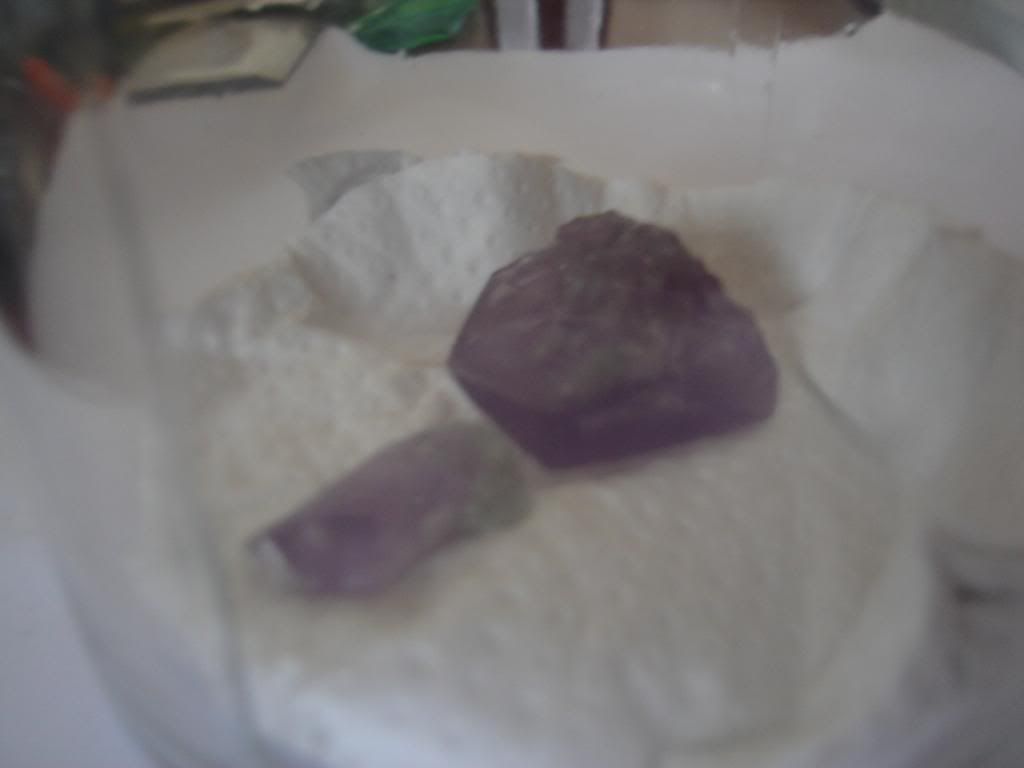
Into a well acidified solution of mohr's salt (to say, it was the supernatant of a four-fold crystalization process) you put some pieces of aluminium,
set as an immersed scroll, enough to fit into the beaker, and not too much so that about 5mm gaps between each spiral. The aluminium will dissolve,
and this will chain the formation of crystals which certainly have aluminium in their formulas. Note that the solution was initially already
saturated, so I would propose that crystal formation is due to reaction times, since aluminium first hurry to dissolve, then crystals are slowly
formed. The whole processes took about a week.
This is what I am talkign about, whatever it is FeIII, then a sort of selective precipitation occurred, and we all know FeIII is commonly more soluble
than FeII, so such a sort of an match of ions must have occurred.
[Edited on 11-20-2012 by Poppy]
|
|
|
blogfast25
International Hazard
    
Posts: 10562
Registered: 3-2-2008
Location: Neverland
Member Is Offline
Mood: No Mood
|
|
I obtained some ferric alum (ammonium) crystals co-existing with some Mohr's salt crystals also, some weeks ago. In my case it was due to incomplete
oxidation of the Fe (II) to Fe(III) during synthesis of the ferrric ammonium alum.
|
|
|
Poppy
Hazard to Others
  
Posts: 294
Registered: 3-11-2011
Member Is Offline
Mood: † chemical zombie
|
|
In your case there were FeII as an impurity, in my case it is FeIII that was an impurity.
Interesting is Al should have reduced pretty much of the FeIII floating around. Also, a lot of aluminium has deposited at the bottom as a powder, its
dissolution was not complete.
I will try this again with pure re-crystalized mohr's salt.
Im scared because the bigger sample is 1 inch in diameter, it has sharp and flat surfaces, caractherics of a well formed crystal. Normally that would
require careful manage and temperature control for crystal growing this large.
The word alum is making more sense to me now.
Any hints on the behaviour of these?
[Edited on 11-20-2012 by Poppy]
|
|
|
platedish29
Hazard to Self
 
Posts: 76
Registered: 2-9-2012
Member Is Offline
Mood: absorbing CO2
|
|
Refer to MinDat.Org There is plenty of minerologic data along with pictures. Its a lot of fun. Most are largely discussed. Maybe it will help on your
interests.
|
|
|